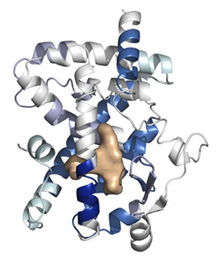

Scientists Shed Light on Stabilization Dynamics of Important Nuclear Receptor
By Eric Sauter
In addition to providing an example of creative alliteration, peroxisome proliferator activated receptors (PPARs) play a critical role in regulating lipid and glucose metabolism. Eagerly sought as drug targets in both diabetes and dyslipidemia, knowledge of these receptors has resulted in several drugs reaching the market, and even more currently being tested in the laboratory—not only for metabolic disease, but also for inflammation, Alzheimer's, and cancer.
Nuclear receptors, a class of proteins activated by small molecule ligands, bind to DNA, giving them control over specific gene expression. The exact biological function of nuclear receptors can be altered by the recruitment of coactivators as well as by ligand-induced changes in the ligand binding domain, which recognizesspecific ligands.
In particular, PPARγ is activated by the thiazolidinediones, synthetic agonists that are used as antidiabetic agents to improve insulin sensitivity, although red flags have been raised about some serious adverse side effects of these drugs.
Recently, however, a group of Scripps Research scientists on the Jupiter, Florida campus discovered that not all PPARγ ligands are equal in their impact on the receptor. While full agonists stabilized the helix 12 (H12) area of the receptor's ligand binding domain—critical for full agonist activity—partial or intermediate stage agonists did not. Instead, they stabilized other regions, producing some unique changes in the dynamics in the binding domain.
The study appeared in the October 16, 2007 (Vol 15, Number 10, pp.1258-1271) edition of the journal Structure.
The scientists' findings bring into serious question the current theory that stabilization dynamics of the H12 area act as the sole molecular switch for all PPARγ agonists.
The findings also raise the possibility that changes in ligand receptor interaction may produce important differences in the pharmacology of current and future antidiabetic agents. With these differences come the potential for reducing adverse side effects.
"The type of binding mode leads to differential downstream effects," said Patrick R. Griffin, chairman of the Department of Molecular Therapeutics at Scripps Florida, who led the study. "We wanted to understand what the molecular determinants were that acted as the switch. We now know that it isn't always Helix 12—which only plays a role when full ligands interact with it. The partial or weak agonists make contact with different regions of the binding pocket which, until our study, weren't thought to be important in activating the receptor."
While some recent studies have suggested that graded transcriptional responses only derive from different modulations of the H12 region of the ligand binding domain, the new study clearly refutes that hypothesis, suggesting instead that stabilization of the binding domain by these weak or intermediate ligands—those with levels of transactivation less than 80 percent efficacy—derives from a distinct mechanism.
And, as Griffin points out, the new study highlights the importance of a more complete understanding of the mechanism of ligand modulation of PPARγ and other nuclear receptors, particularly as it applies to drug development.
"It opens a new avenue of thinking about modulating nuclear receptors," Griffin said, "Our study demonstrates that it's no longer a simple matter of stabilizing a single region and recruiting a co-activator. You can make the receptor do different things depending on how and where the ligand interacts with the binding site. From a drug development point of view, this offers a new area of the protein to focus on to optimize molecules."
To make the new findings, Griffin and his colleagues used a combination of x-ray crystallography and protein amide hydrogen exchange. Protein amide hydrogen exchange—which maps protein kinetics through the known rates of the hydrogen atom exchange between the main chain amides of proteins and a solvent—is often described as a convoluted process. Nonetheless, the study shows that in combination these methods can provide a powerful tool for producing novel insights into the mechanism of ligand activation of nuclear receptors.
Other authors of the study, Partial Agonists Activate PPARγ Using a Helix 12 Independent Mechanism, include John B. Bruning, Michael J. Chalmers, Swati Prasad, Scott A. Busby, Theodore M. Kamenecka, Yuanjun He and Kendall W. Nettles of The Scripps Research Institute.
The study was supported by the State of Florida.
Send comments to: mikaono[at]scripps.edu

The new study from the Griffin lab highlights the importance of a more complete understanding of the mechanism of ligand modulation of PPARγ and other nuclear receptors, particularly as it applies to drug development. Click for image details.
